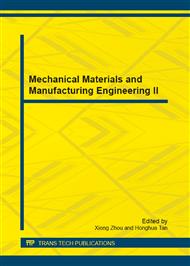[1]
Ming, X. G., Yan, J. Q., Wang, X. H., Li, S. N., Lu, W. F., Peng, Q. J., & Ma, Y. S. (2008). Collaborative process planning and manufacturing in product lifecycle management. Computers in Industry, 59(2-3).
DOI: 10.1016/j.compind.2007.06.012
Google Scholar
[2]
Marais, K. B., Saleh, J. H. (2009). Beyond its cost, the value of maintenance: An analytical framework for capturing its net present value. Reliability Engineering & System Safety, 94(2).
DOI: 10.1016/j.ress.2008.07.004
Google Scholar
[3]
Tavares, S. S. M., Corte, J. S., Menezes, L., Moura, V., & Corte, R. R. a. (2009). Failure analysis of an austenitic stainless steel stud in seawater oil platform. Engineering Failure Analysis, 16(1).
DOI: 10.1016/j.engfailanal.2008.05.008
Google Scholar
[4]
Tavares, S. S. M., Pardal, J. M., Corte, J. S., Scandian, C., & Herculano, L. F. G. (2009). Failure induced by severe wear between studs and nuts of 17-4PH steel. Engineering Failure Analysis, 16(5).
DOI: 10.1016/j.engfailanal.2009.01.008
Google Scholar
[5]
Jensen, W. J, (2003). Corrosion in Threaded Fasteners. ASM International.
Google Scholar
[6]
ASTM International, (2004), Standard Specification for Alloy-Steel and Stainless Steel Bolting Materials for High Temperature Service.
Google Scholar
[7]
Eliaz, N., Gheorghiu, G., Sheinkopf, H., Levi, O., Shemesh, G., Ben-Mordechai, A., & Artzi, H. (2003). Failures of bolts in helicopter main rotor drive plate assembly due to improper application of lubricant. Engineering Failure Analysis, 10(4).
DOI: 10.1016/s1350-6307(03)00018-9
Google Scholar
[8]
Baggerly, R. (2000). Evaluating the Effects of Overtorque in Bolts. Journal of Failure Analysis and Prevention, 41-46.
Google Scholar
[9]
Dahl, J. S., Lu, L. -wu, Fisher, J. W., & Abruzzo, J. (1996). Comparative Effectiveness of Tightening Techniques for A4901 Vi-in . Diameter Bolts. Engineering, (3), 77-80.
Google Scholar
[10]
Gordon, D. F. (2005). Hydrogen re-embrittlement susceptibility of ultra high strength steels. Thesis. Cranfield University.
Google Scholar
[11]
Kodur, V., Kand, S., & Khaliq, W. (2012). Effect of Temperature on Thermal and Mechanical Properties of Steel Bolts. Journal of Materials in Civil Engineering.
DOI: 10.1061/(asce)mt.1943-5533.0000445
Google Scholar
[12]
Hobbs, J. M. (2010). High Temperature Fastener Fatigue. Thesis. University of Utah.
Google Scholar
[13]
Fares, Y. (2006). Fatigue design of bolted joints using multiaxial fatigue criteria. Thesis. INSAT.
Google Scholar
[14]
Koning, A. D., & Henriksen, T. (1996). Damage tolerance analysis of bolt/nut assemblies. Nationaal Lucht EN.
Google Scholar
[15]
Zhao, H. (1998). Stress concentration factors within bolt-nut connectors under elasto-plastic deformation. Int. J. Fatigue, 20(9).
DOI: 10.1016/s0142-1123(98)00036-x
Google Scholar
[16]
Agatonović, P. (2011). Structural integrity analysis of multi-bolted connections using the innovative beam model. Integritet i vek konstrukcija, 11(3).
Google Scholar
[17]
Garrigou, A., Carballeda, G., Daniellou, F. (1998). The role of know-how, in maintenance activities and reliability in a high-risk process control plant. Applied Ergonomics, 29(2).
DOI: 10.1016/s0003-6870(96)00060-9
Google Scholar
[18]
Pak, K. G., & Sodhi, R. (2002). Destructive Disassembly of Bolts and Screws by Impact Fracture. Journal of Manufacturing Systems, 21(1994).
DOI: 10.1016/s0278-6125(02)80170-4
Google Scholar
[19]
ISO 68-1: 1999-03.
Google Scholar


